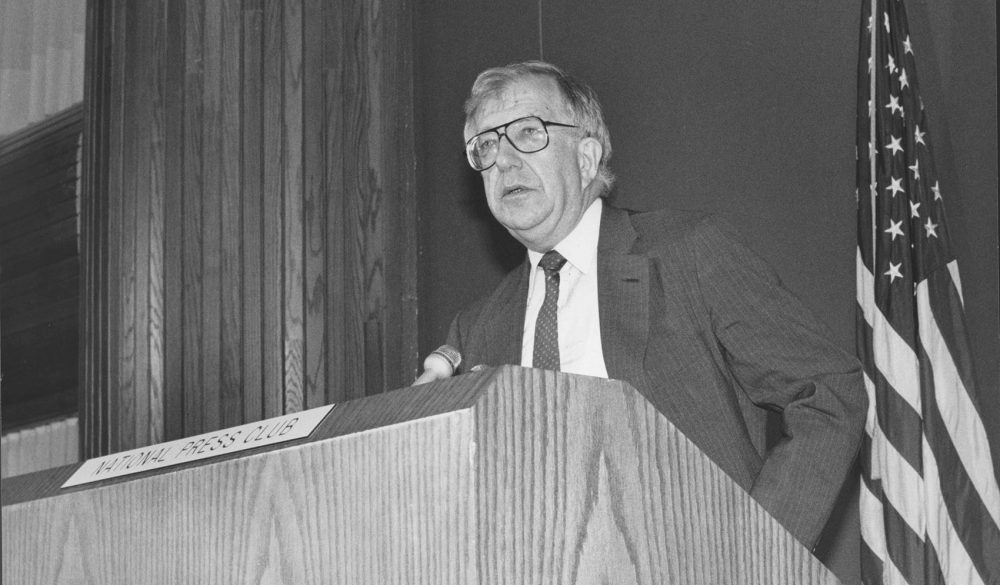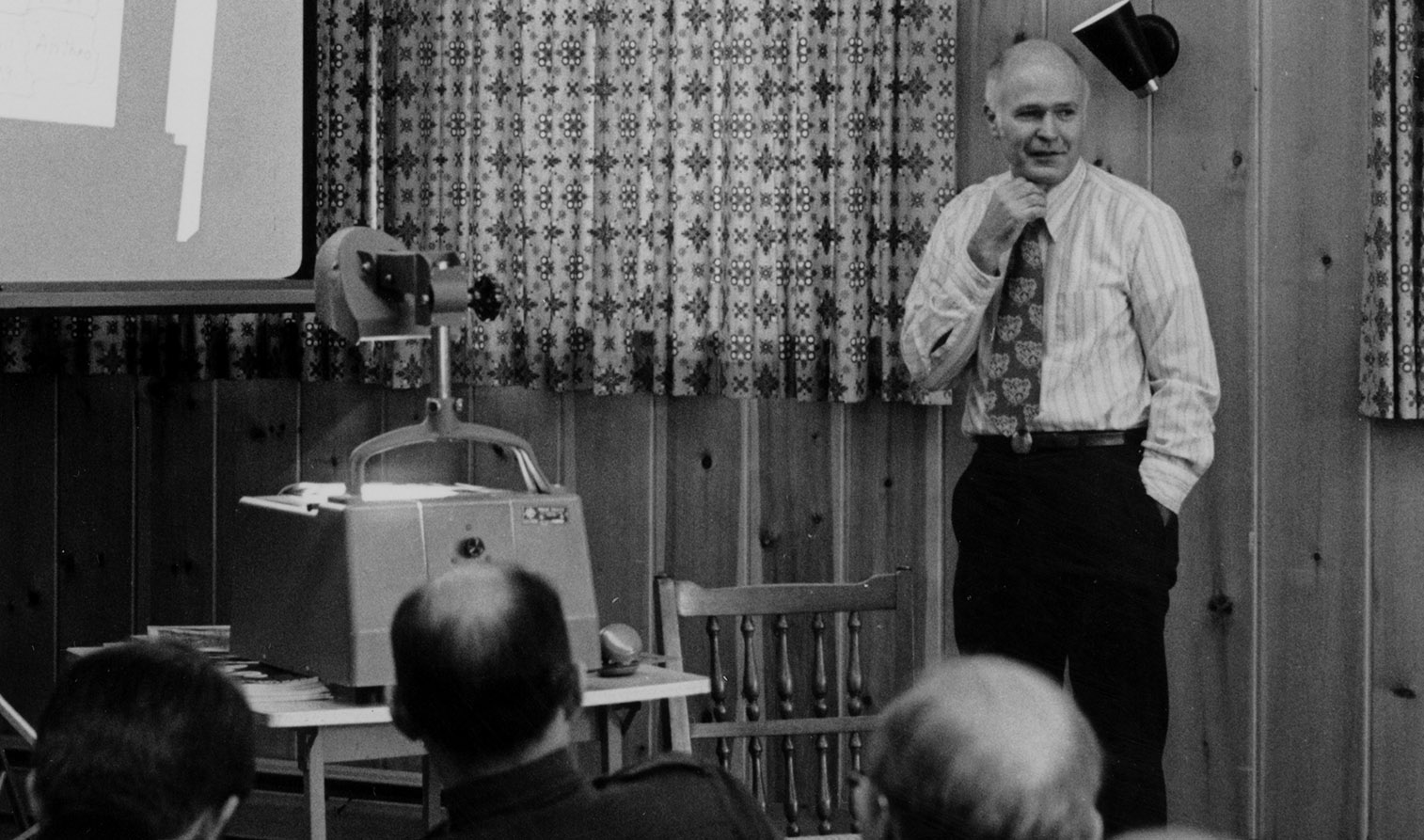Advertisement
Charter Schools Began In A Surprising Way: With A Union Leader
Resume
This fall, yellow-shirted brigades of teachers, parents and students are using yard signs, leaflets and door-knocking to oppose Question 2, the initiative that would allow 12 new or expanded charter schools in Massachusetts every year.
But behind that grassroots energy is more than $13 million from local and national teachers’ unions funding TV advertisements.
So it may be surprising that the charter idea was first popularized in 1988 by a union leader: Al Shanker, the legendary 25-year president of the American Federation of Teachers.
It’s part of his unique profile in American education, said Richard Kahlenberg, Shanker’s biographer and co-author of “A Smarter Charter,” with Halley Potter.
“Al Shanker was not only a teacher union leader, he was an education reformer,” said Kahlenberg. “So he was constantly proposing new ideas and innovations in education.”
Shanker first found the phrase in “Education by Charter,” a book by Ray Budde, an obscure academic and school administrator based in western Massachusetts.
Budde was a passionate would-be reformer inspired by the philosopher John Dewey, whom he quoted in the epigraph to the book: “All other reforms are conditioned upon reform in the quality and character of those who engage in the teaching profession.”
“Education by charter” was supposed to do just that. Budde proposed that a flattening of school districts — from a four-tier, almost military organization of school boards, superintendents, principals and teachers to a flexible two-part order, in which groups of educators would petition school committees for a charter to form a new school — could induce teachers to invest anew in what happened in their classrooms.
When Budde first wrote about this idea in 1974, he was disappointed to get little attention.
“The response: zero. Nothing,” Budde wrote. “It soon became evident that I was pushing something that was simply not going to happen.”

Panic And 'A Nation At Risk'
But by the 1980s, the national mood had changed — into a panic.
“A Nation at Risk,” a White House report released in 1983, likened America’s educational shortcomings to a Soviet program of subversion. The report’s authors blamed “ballooning bureaucracy” for test results falling across the board, and President Ronald Reagan received the report as a spur “to restore quality to education by increasing competition and by strengthening parental choice and local control.”
“A Nation at Risk” has been criticized in recent years for its apocalyptic tenor — but such was the atmosphere in which Budde turned his 15-year-old idea into a book.
Al Shanker was also thinking about “A Nation at Risk” when Budde’s book first came across his desk. He too blamed the bureaucracy of education for creeping mediocrity, but from a teacher’s perspective. He believed that enterprising teachers could find ways to get through to the 80 percent of students who weren’t thriving in American schools, but that the system wouldn’t let them.
Shanker likened the existing model to a doctor telling an unhappy patient, “You’ve got a hell of a lot of nerve not responding to my pill.”
New Model — With A New Name
In January 1988, Shanker wrote in his weekly advertising space in The New York Times: “Here in the U.S., there is much talk of teacher empowerment, but what does empowerment mean if the school schedule, teacher and pupil class assignment, etc. have all been made in advance?”
Shanker proposed a solution intended to ennoble educators — and set them free.
He’d seen it on a 1987 visit to the Holweide Gesamtschule in Cologne, Germany. The experimental school paired a diverse mix of struggling students with a committed team of teachers who wrote their own curriculum, chose their own roles and stuck with the same cohort of children for six years.
Shanker developed his vision (in conversation with others) for months, and by July it had taken shape as a great project of “risk-taking and change”: hundreds or thousands of “small learning communities … actively looking for better ways” to educate all children.
He had trouble finding a name for the reform, so he borrowed one from his latest reading: “The best answer so far is ‘charter schools,’ a suggestion made by Ray Budde,” Shanker wrote. It was poetic, since “explorers got charters to seek new lands.”
Richard Kahlenberg noted that the idea of charter schools that took shape inside traditional school districts wasn’t what Ray Budde had in mind. But that wasn’t at all atypical: “That’s what Al Shanker often did — to synthesize ideas from other people, and to have a platform from which to bring them out of obscurity and into the mainstream.”
Only months later, two concerned citizens, Joe Nathan and Ted Kolderie, invited Al Shanker to St. Paul, Minnesota. There they incorporated his insights into the nation’s first charter school legislation, which passed in the state legislature on June 4, 1991.
The rest is checkered history. How you see the story of charter schools becoming the market-friendly favorite reform of hedge-fund managers and the Walton Foundation depends on what you think they’re supposed to do.
Tragedy Or Innovation?
Richard Kahlenberg, who’s also a fellow at the liberal Century Foundation, described it as a tragedy.
“What happened, quite frankly, is the right wing hijacked Al Shanker’s very small-d democratic idea: that you’d have workplace democracy, where teachers would try out new ideas, where you’d have this beautifully integrated school environment,” Kahlenberg said. “Instead, some conservatives saw charters as a way of making an end run around teachers’ unions.”
But Paul Peterson, who serves as editor-in-chief of the pro-reform journal Education Next, faulted district schools for failing to incorporate charters’ new methods. As a result, he said, members of the charter movement have been forced to fight for their lives.
He cited the success of the KIPP network of charter schools. If their combination of rote education and a no-excuses attitude toward student misbehavior works to improve test scores, he said, why hasn’t the KIPP model gone mainstream?
“There’s nothing that prevents the public schools from adopting these ideas, and fighting back,” said Peterson. “But there’s been a reluctance to adopt these approaches.”
That tension — about whether charter schools are supposed to collaborate, or compete — goes back to the idea’s ambiguous beginnings.
Consider the 1993 legislation that provided for Massachusetts’ first charter schools. It made six arguments for why the new institution would be useful. Three of those mention innovation, diversity, teacher leadership and inter-school collaboration. The other three focus on teacher accountability and parental choice.
As charter schools began to employ non-union teachers, some with intense workloads on short-term contracts — and, in some cases, seemed to cherry-pick their districts’ less challenging students — Al Shanker despaired over what he had set in motion. By 1993, he was dismissing charters as a “mechanical gimmick” in the same space that he’d used to broadcast the idea five years earlier.
'It Is Just So Difficult'
But Ted Kolderie — the Minnesota reformer who actually put the charter idea into practice — sees the good on both sides. He said it’s the story of a fumbling attempt to force the behemoth of American education to improve itself.
“The integrating objective was an effort to get this huge, $600-billion-a-year system to begin to change. It is just so difficult, even when it’s desperately needed,” Kolderie said. “In California the education code is a stack of books about a foot high. The idea was if you could just liberate students and teachers to try things, it would be a way to integrate change into K-12.”
Whatever you think of what happened, that kernel of an idea — that school diversity ought to reflect the diversity of students — still makes as much sense as ever. The question is whether unleashing charter schools on a corporate, or competitive, model is the means by which to achieve it.
There’s another question, too. Could charters themselves go back to their roots? Richard Kahlenberg told me that Al Shanker’s vision might be making a comeback in a small but growing number of charter schools.
“Some are taking steps to be more economically and racially integrated, or providing teachers with the opportunity to be involved in the hiring and firing of new teachers, with developing the curriculum,” Kahlenberg said. “And some charter schools — a small number — are reaching out to traditional public schools to share ideas.”
He celebrates a few of these “smarter charters” for putting Shanker’s idea into practice, including Morris Jeff Charter School in New Orleans, City Neighbors in Baltimore and High Tech High in San Diego.
All this is to say that the charter story is still unfolding, almost 30 years after it began. And Massachusetts voters will add to the story on Nov. 8.
This segment aired on November 4, 2016.

